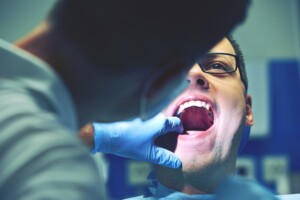An oral surgeon talks about an oral cancer that you probably have never heard of – and it can be deadly if not treated in time.
You’ve probably heard of squamous cell carcinoma, the most common form of oral cancer.
The tongue is the most common site, which is why most people will talk about it.
However, another oral cancer is salivary gland cancer.
There are a number of them, but the most common salivary gland cancer is called mucoepidermoid carcinoma and is typically found within the parotid salivary gland.
The second most common area is within the minor salivary glands, which can be found on the palate, aka roof of the mouth.
These cancers are usually low-grade but can sometimes be intermediate or high-grade.
Treatment of these cancers is similar to other cancers and would involve complete excision to remove the tumor.
Oral Cancer Screenings

Shutterstock/Jaromir Chalabala
It is very important to get screened. Routine oral cancer screenings at least once per year are recommended in identifying suspicious lesions, early diagnosis and treatment.
Identifying a cancerous or precancerous lesion early when it’s small makes the surgery easier and less destructive.
Cancerous lesions do not go away with time; they only grow larger.
The larger they are, the bigger the surgery will be and the more deforming for the patient.
Warning Signs of Salivary Gland Cancer
The most common warning sign of possible salivary gland cancer is a lump or swelling in the face or neck.
More rarely, these lumps can appear somewhere in the mouth or throat, and in extremely rare cases, salivary gland cancers can arise in other parts of the head and neck, i.e., within muscles or bones.
Other potential warning signs include pain in your mouth, cheek, jaw, ear or neck that doesn’t go away, numbness of the oral or facial structure, weakness of the muscles on the side of the face, and pain or difficulty in swallowing, and decreased ability or inability to open the mouth wide.
Be on the lookout for anything that does not go away after 2-4 weeks, is red or looks like an ulcer; and anything that bleeds should be looked at.
Anything firm that restricts motion (such as tongue motion) is also concerning.
When in doubt, always go see your dentist. It’s better to be told it’s nothing than to let something go that is cancer.
Catching Oral Cancer Early
Prevention and early detection of oral cancer is crucial to saving lives.
Worldwide, oral cancer is the 12th most common cancer, and all head and neck cancers combined rank fifth overall.
In the U.S., over 50,000 new cases of oropharyngeal cancer were estimated in 2020, and over 10,000 people will die [per year] of this disease.
Oral cancer, like any other cancer, is multifactorial, and there is not one specific cause (especially for salivary gland cancers like mucoepidermoid carcinoma).
For this reason, it’s important to have a complete head and neck examination performed annually or more frequently in high-risk patients.
Dentists are at the front line of early detection of oral cancer or discovering any oral mucosal abnormalities.
The earlier cancer is detected, the better the chance of treating it successfully.
Typically all oral cancers start out as abnormalities in your mouth which can be seen by a dentist or your oral surgeon.
These abnormalities often first appear as white or red precancerous lesions inside the mouth.
Both your PCP and your dentist should perform routine oral cancer screenings for any unusual pathology.
Dentists would most likely perform a more thorough exam, and if an abnormality is seen, they would likely refer you to an oral/maxillofacial surgeon.
If you develop any oral lump/bump/lesion, oral or facial numbness, or have difficulty swallowing or opening your mouth, you should not delay seeking medical attention.
Doctors you can see include: oral and maxillofacial surgeons, ENT surgeons, dentists or your PCP.
From there, if a referral is indicated, they can get you to the right place.
Making your dentist a part of your cancer prevention team is crucial when it comes to not only oral cancer detection and prevention — but your overall health.
This is why it’s recommended that you visit your dentist at least twice a year, which allows them to get a look in your mouth and the chance to spot the first signs of oral cancer.
Dentists can also feel for signs of cancers of major salivary glands or the oropharynx.
The Oral Cancer Assessment
On your initial visit, the majority of dentists begin a basic oral cancer assessment.
This 90-second check involves looking for and feeling for any indications of cancer.
But if you want to be certain, ask your dentist if they have examined your mouth for indications of oral cancer.
Even for those younger individuals who are thought to have a decreased risk of oral cancer, this examination should be performed.
Early detection of oral cancer by a dentist or expert of the mouth greatly improves your prognosis and treatment outcomes.
 Dr. Jaclyn Tomsic is a board certified oral and maxillofacial surgeon. This involves extensive dental and medical education/training to achieve surgical expertise, plus an unparalleled understanding of esthetics and function that uniquely qualifies them to treat the conditions, defects, injuries and esthetic aspects of the mouth, teeth, jaw and face.
Dr. Jaclyn Tomsic is a board certified oral and maxillofacial surgeon. This involves extensive dental and medical education/training to achieve surgical expertise, plus an unparalleled understanding of esthetics and function that uniquely qualifies them to treat the conditions, defects, injuries and esthetic aspects of the mouth, teeth, jaw and face.
.



























